oil filter CHEVROLET BLAZER 1993 Owners Manual
[x] Cancel search | Manufacturer: CHEVROLET, Model Year: 1993, Model line: BLAZER, Model: CHEVROLET BLAZER 1993Pages: 386, PDF Size: 20.7 MB
Page 280 of 386
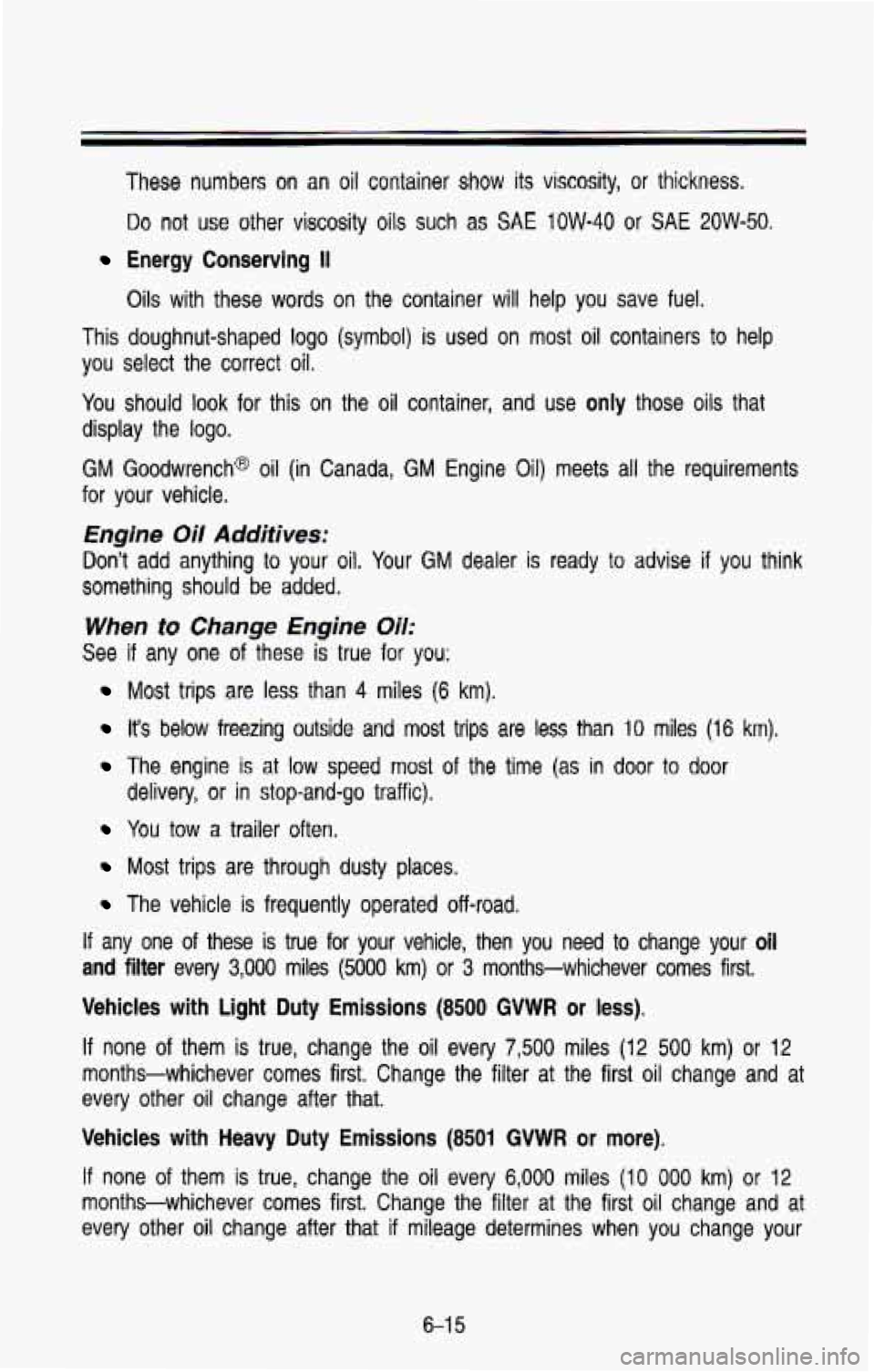
These numbers on an oil container show its viscosity, or thickness.
Do not use other viscosity oils such as SAE 1OW-40 or SAE 2OW-50.
Energy Conserving II
Oils with these words on the container will help you save fuel.
This doughnut-shaped logo (symbol) is used on most oil contai\
ners to help
you select the correct oil,
You should look for this on the
oil container, and use only those oils that
display the logo.
GM Goodwrench@ oil (in Canada, GM Engine Oil) meets all the requirements
for your vehicle.
Engine Oil Addifives:
Don't add anything to your oil. Your GM dealer is ready to advise if you think
something should be added.
When to Change Engine Oil:
See if any one of these is true for you;
Most trips are less than 4 miles (6 km).
It's below freezing outside and most trips are less than 10 miles (16 km).
The engine is at low speed most of the time (as in door to door
You tow a trailer often.
Most trips are through dusty places.
The vehicle is frequently operated off-road. delivery, or in stop-and-go
traffic),
If any one of these is true for your vehicle, then you need to change your oil
and filter every 3,000 miles (5000 km) or 3 months-whichever comes first.
Vehicles with Light Duty Emissions (8500 GVWR or less).
If none of them is true, change the oil every 7,500 miles (1 2 500 km) or 12
months-whichever comes first. Change the filter at the first oil change and at
every other oil change after that.
Vehicles with Heavy Duty Emissions (8501 GVWR or more).
If none of them is true, change the oil every 6,000 miles (1 0 000 km) or 12
months-whichever comes first. Change the filter at the first oil change and at
every other oil change after that if mileage determines when you change your
6-1 5
Page 281 of 386

Service & Appearance Care
oil. If time determines when you change your oil, change the filter ea\
ch time
you change your oil.
Engine Block Heater:
An engine block heater can be a big help if you have to park outside in very
cold weather,
0°F (-18°C) or colder. If your vehicle has this option, see
“Engine Block Heater” in the Index.
What to Do with Used Oil:
Used engine oil contains things that have caused skin cancer in
laboratory animals. Don’t let
used oil stay on your skin for very long.
Clean
your skin and nails with soap and water, or a good hand ,,:: :‘:-;
cleaner. Wash or properly throw away clothing or rags containing-:’-:;$ ~
used engine oil.
. ,A:<< --.
L. .. . .. ,-. f .- , L ., -J ’,: ._ - -
..:.: ;,i, j I -.. : j ,!
Used oil can be a real threat to the environment. If YOU change your own oil,
be sure to drain all free-flowing oil from the filter before disposal. Don’t ever
dispose of oil by putting it in the trash, pouring it on the ground, into sewers,
or into streams or bodies of water. Instead, recycle it by taking it to a place
that collects used oil. If you have a problem properly disposing of your used
oil, ask your dealer, a service station or a local recycling center for help.
Air Cleaner
c
PO21 6
Refer to the Maintenance Schedule to determine when to replace the air
cleaner filter and crankcase ventilation filter. See “Schedule\
d Maintenance Services” in the Index.
6-1 6
Page 282 of 386
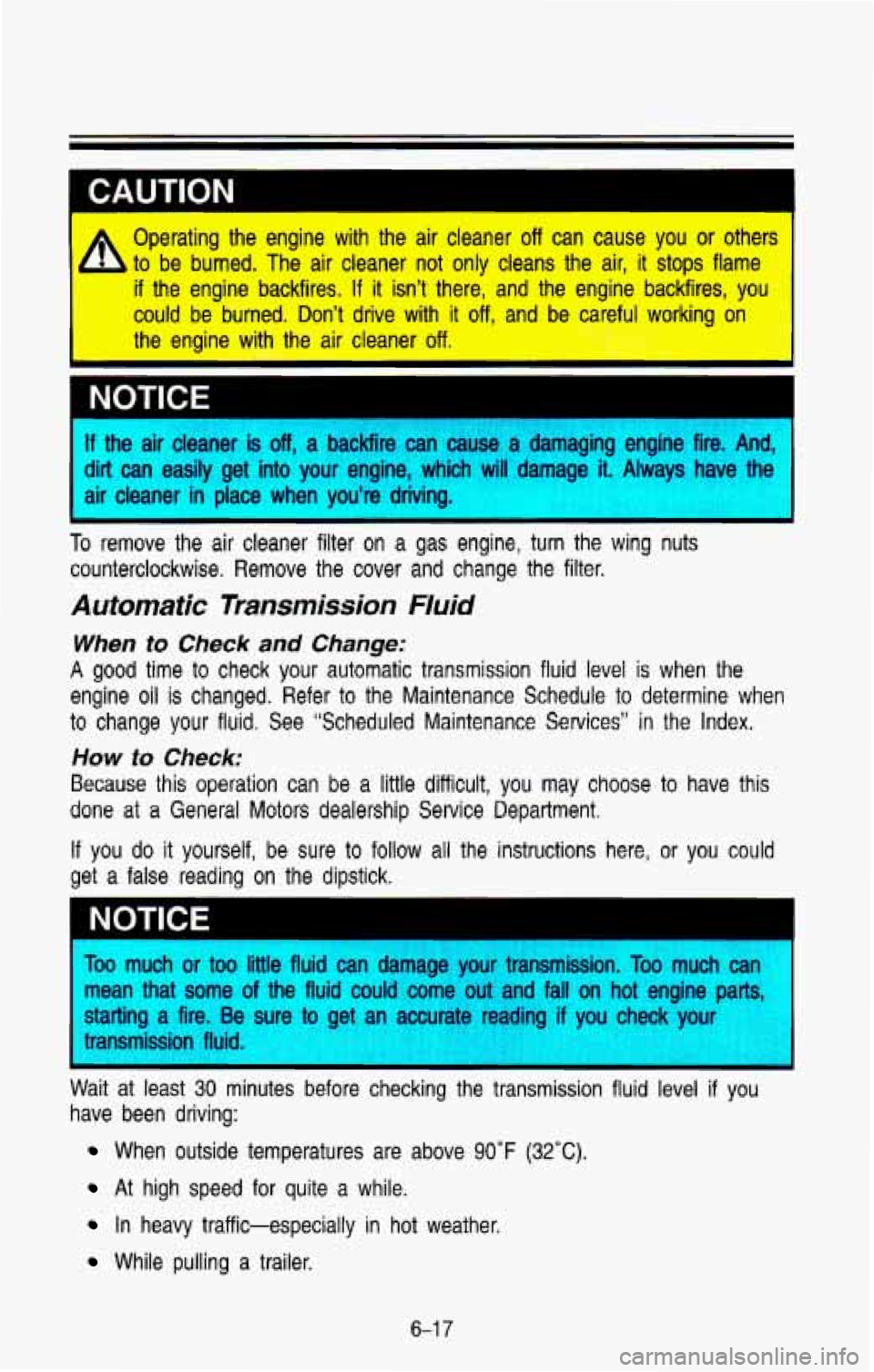
I CAUTION
I 10 Operating the engine with the air cleaner off can cause you or others
to be burned. The air cleaner not only cleans the air, it
stops flame
if the engine backfires.
If it isn’t there, and the engine backfires, y(--
could be burned. Don’t drive with it
off, and be cr-ful working on
the engine with the air cleaner
off.
~
NOTICE I
If the air cleaner is off, a backfire can cause a damaging engine fire. And,
dirt
can easily get into your engine, which will damage it. Always have the
air cleaner
in place when you’re driving.
Ib remove the air cleaner filter on a gas engine, turn the wing nuts
counterclockwise. Remove the cover and change the filter.
-
Automatic Transmission Fluid
When to Check and Change:
A good time to check your automatic transmission fluid level is when the
engine
oil is changed. Refer to the Maintenance Schedule to determine when
to change your fluid. See “Scheduled Maintenance Services” in \
the Index.
How to Check:
Because this operation can be a little difficult, you may choose to have this
done at a General Motors dealership Sewice Department.
If you do it yourself, be sure to follow all the instructions here, or you could
get
a false reading on the dipstick.
NOTICE I
I
Too much or too little fluid can damage your transmission. Too much can
mean that some of the fluid could come out and fail
on hot engine parts,
I
starting a fire. Be sure to get an accurate reading if you check-your
transmission fluid.
Wait at least
30 minutes before checking the transmission fluid level if you
have been driving:
When outside temperatures are above 90°F (32°C).
At high speed for quite a while.
In heavy traffic-especially in hot weather.
While pulling a trailer.
6-1 7
Page 334 of 386
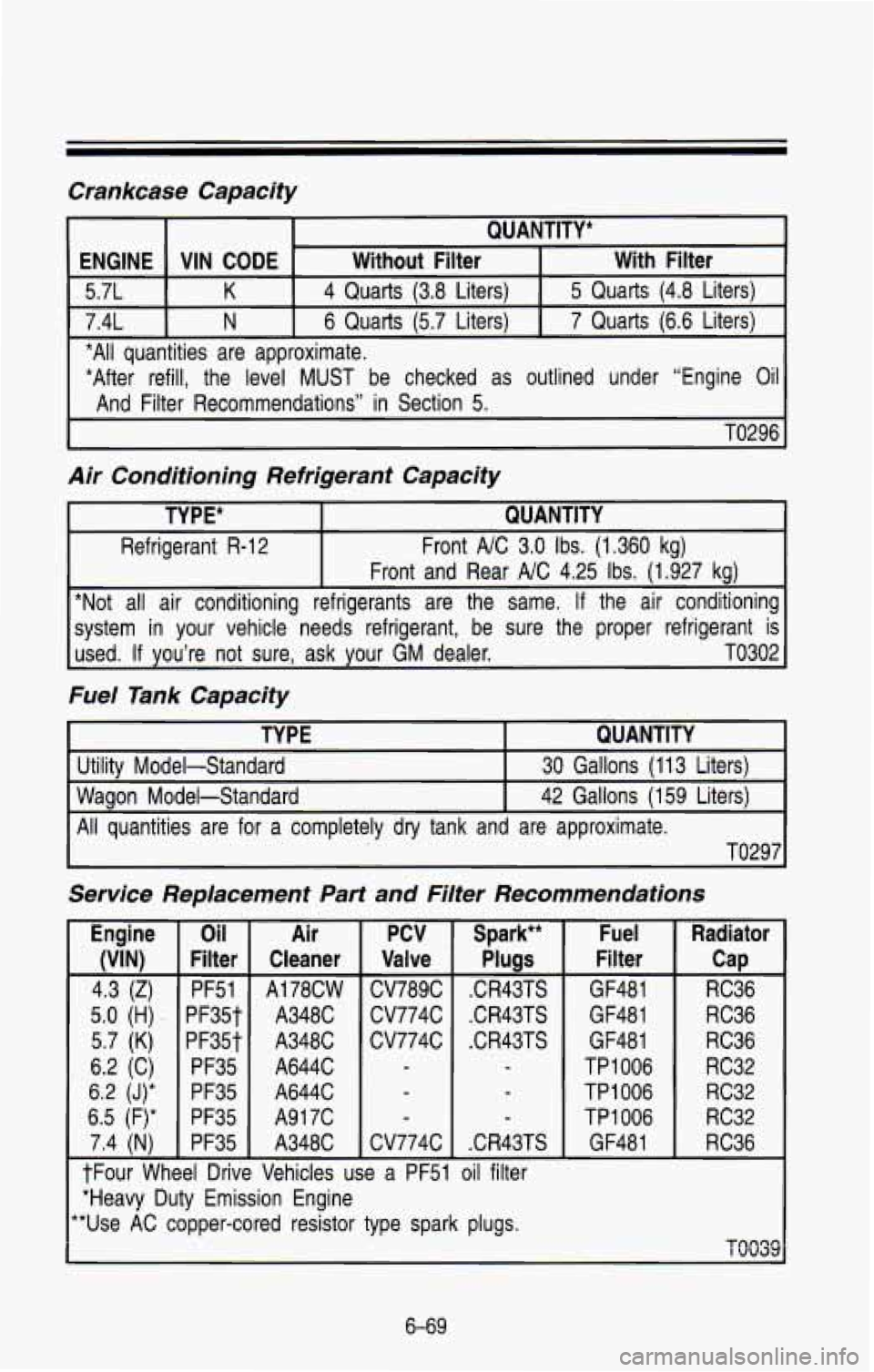
Crankcase Capacify
QUANTITY*
ENGINE VIN CODE Without Filter With Filter
5.7L K 4 Quarts (3.8 Liters) 5 Quarts (4.8 Liters)
7.4L N 6 Quarts (5.7 Liters) 7 Quarts (6.6 Liters)
*All quantities are approximate.
*After refill, the level MUST be checked as outlined under “\
Engine Oil
TO296
And Filter Recommendations” in Section
5.
Air Condifioning Refrigeranf Capacify
TYPE* QUANTITY
Refrigerant R-12 Front
AJC 3.0 Ibs. (1.360 kg)
Front and Rear AJC 4.25 Ibs. (1.927 kg)
*Not all air conditioning refrigerants are the same.
If the air conditioning
system in your vehicle needs refrigerant, be sure the proper r\
efrigerant is
used. If you’re not sure, ask your GM dealer. TO302
Fuel Tank Capacify
I -1
Utility Model-Standard 30 Gallons (113 Liters)
Wagon Model-Standard 42 Gallons (159 Liters)
All quantities are for a completely dry tank and are approxima\
te. TO2971
Service Replacemenf Part and Filfer Recommendations
5.7 (K)
6.2 (C)
6.2
(J)*
6.5 (F)*
-
Oil
Filter
PF5 1
PF35t PF35t
PF35
PF35
PF35
PF35
-
1
Air PCV
Cleaner Valve
A348C
cv774c
A348C cv774c
A644C
A644C
A91 7C
A348C cv774c
AI 7acw cv7agc
Spark**
Plugs
.CR43TS
.CR43TS
.CR43TS
-
.CR43TS i
use a PF51 oil filter
*Heavy Duty Emission Engine
**Use
AC copper-cored resistor type spark plugs.
Fuel
Filter
GF481
GF481
GF481
TP
1 006
TP 1 006
TP 1 006 G F48 1
Radiator
RC36
RC36
RC36
RC32
RC32
RC32
RC36
Cap
6-69
Page 345 of 386
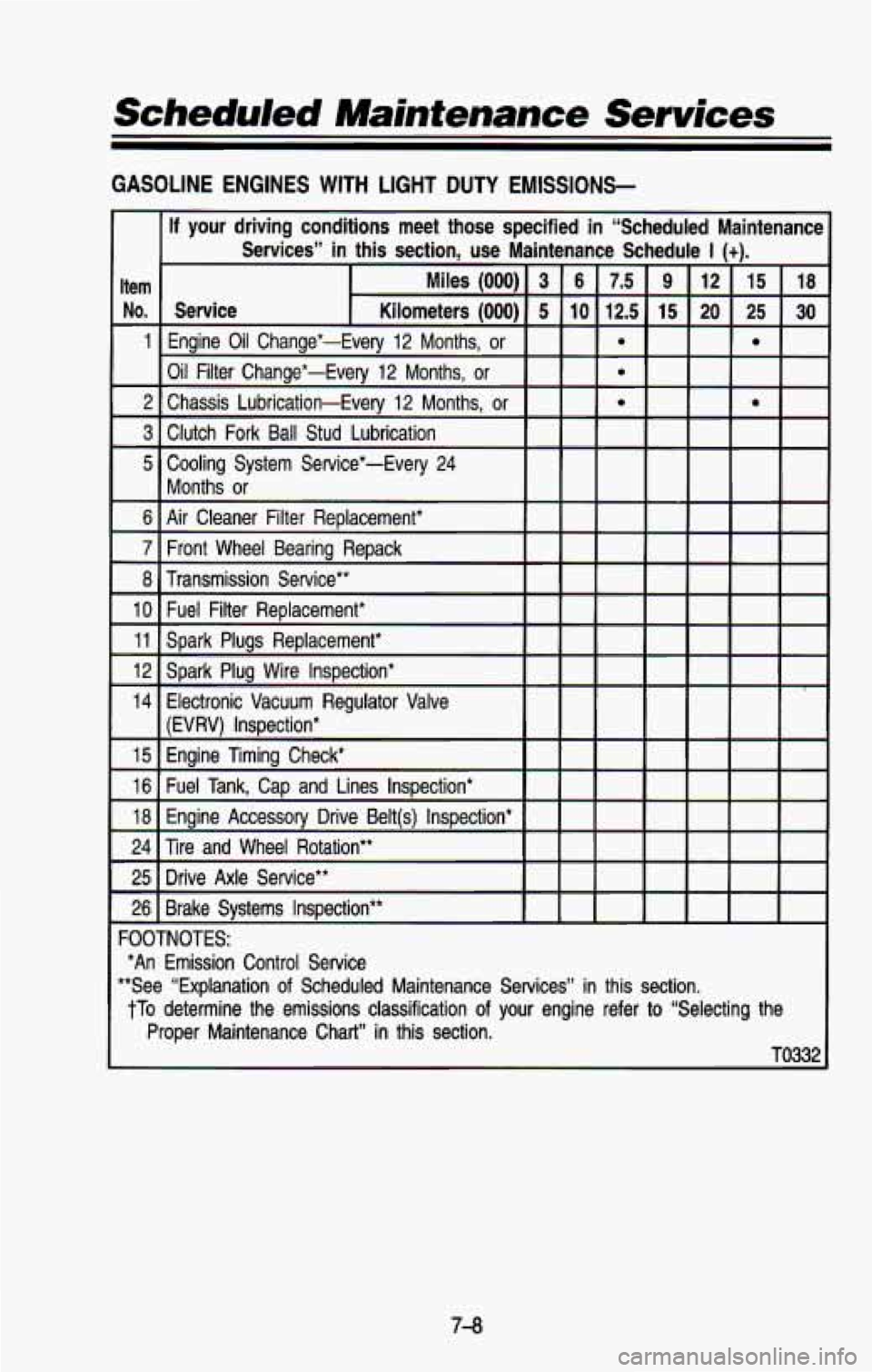
Scheduled Maintenance Services
GASOLINE ENGINES WITH LIGHT DUTY EMISSIONS-
If your driving conditions meet those specified in “Scheduled Ma\
intenancc
Services” in this section, use Maintenance Schedule
I (t).
Item Miles (000) 3 6 7.5 9 12 15 18
No. Service Kilometers (000) 5 10 12.5 15 20 25 30
1 Engine Oil Change*-Every 12 Months, or e
Oil Filter Change*-Every 12 Months, or e
2 Chassis Lubrication-Every 12 Months, or e
3 Clutch Fork Ball Stud Lubrication
5 Cooling System Service*-Every 24
6 Air Cleaner Filter Replacement* Months
or
7 Front Wheel Bearing Repack
8 Transmission Service**
25 Drive Axle Service**
26 Brake Systems Inspection**
FOOTNOTES:
**See “Explanation
of Scheduled Maintenance Services” in this section.
*An Emission Control Service
tTo determine the emissions classification of your engine refer to “Selecting
the
Proper Maintenance Chart”
in this section.
TO332
Page 349 of 386
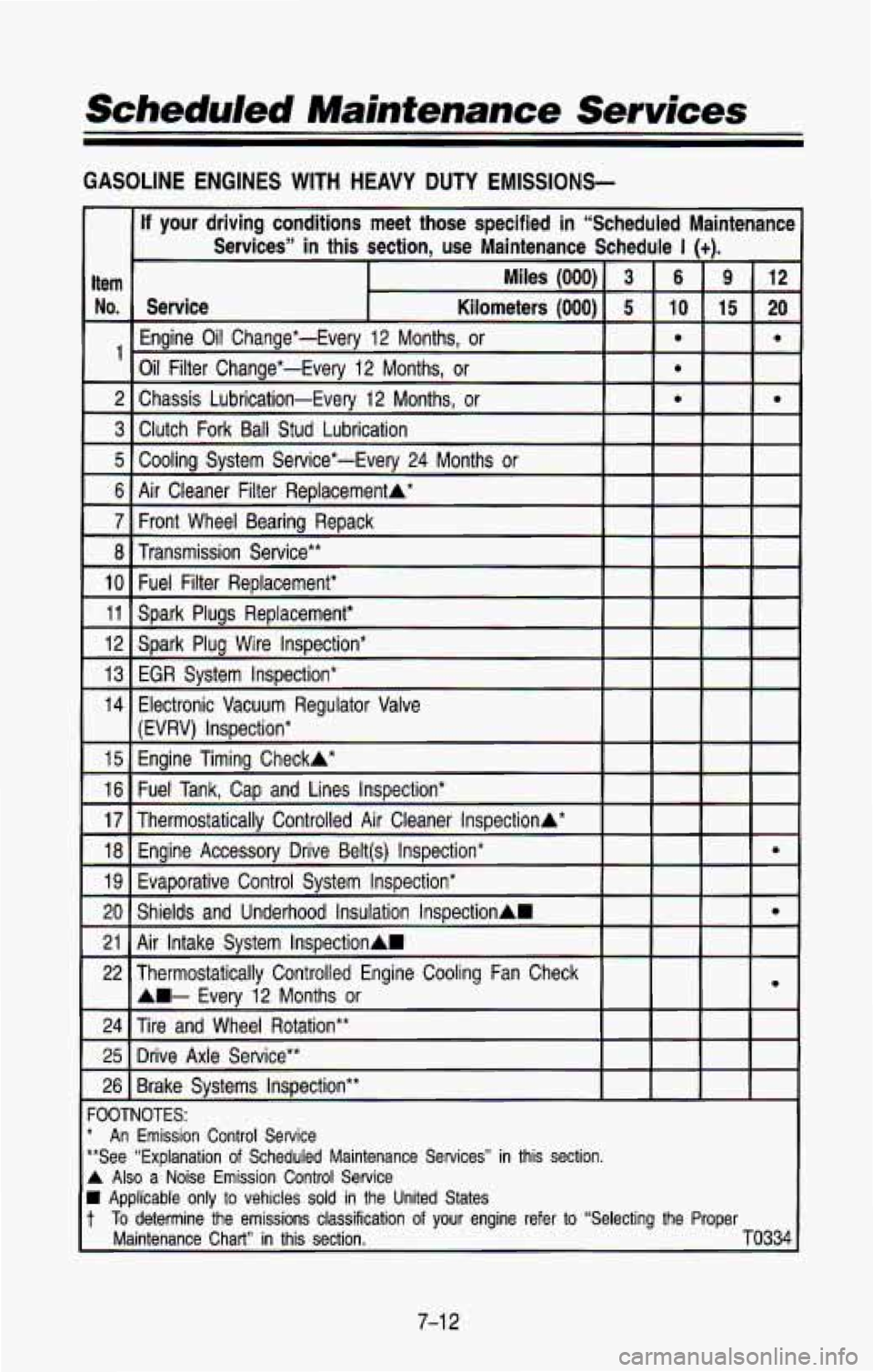
Scheduled Maintenance Services
GASOLINE ENGINES WITH HEAVY DUTY EMISSIONS-
If your driving conditions meet those specified in “Scheduled Ma\
intenancc Services”
in this section, use Maintenance Schedule I (t).
Miles (000) 3 6 9 12
Service Kilometers (000) 5 10 15 20
Item
No.
1-
2
3
5
6
7
8
10
11
12
13
14
15
16 17
18
19 I
20 !
21 1
22
’
.
24 *
25 I
26 I
FOOTNOTES:
* An Emission Control Service
**See “Explanation
of Scheduled Maintenance Services” in this section.
A Also a Noise Emission Control Service
I Applicable only to vehicles sold in the United States
t To determine the emissions classification of your engine refer to “Selecting the Proper
Maintenance Chart” in this section.
T033f
Oil Filter Change*-Every 12 Months, or
Drive Axle Service**
3rake Systems Inspection**
7-1 2
Page 355 of 386
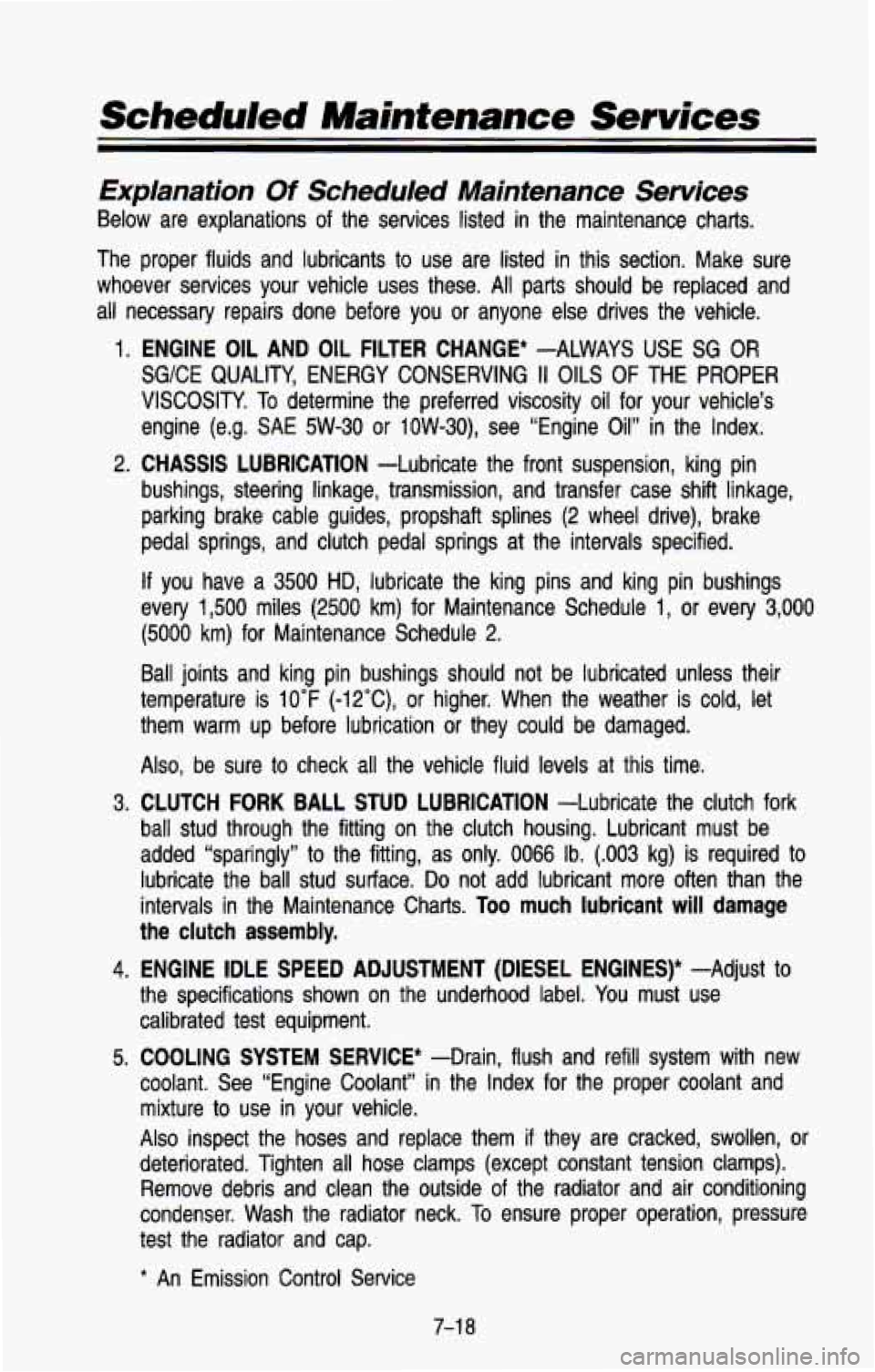
Scheduled Maintenance Services
Explanation Of Scheduled Maintenance Services
Below are explanations of the services listed in the maintenance charts.
The proper fluids and lubricants to use are listed in this section. Make sure
whoever services your vehicle uses these.
All parts should be replaced and
all necessary repairs done before you or anyone else drives the ve\
hicle.
1. ENGINE OIL AND OIL FILTER CHANGE* -ALWAYS USE SG OR
SG/CE QUALITY, ENERGY CONSERVING II OILS OF THE PROPER
VISCOSITY. To determine the preferred viscosity oil for your vehicle’s
engine (e.g. SAE 5W-30 or
10W-30), see “Engine Oil” in the Index.
2. CHASSIS LUBRICATION -Lubricate the front suspension, king pin
bushings, steering linkage, transmission, and transfer case shift\
linkage,
parking brake cable guides, propshaft splines
(2 wheel drive), brake
pedal springs, and clutch pedal springs at the intervals specif\
ied.
If you have a 3500 HD, lubricate the king pins and king pin bushings
every
1,500 miles (2500 km) for Maintenance Schedule 1, or every 3,000
(5000 km) for Maintenance Schedule 2.
Ball joints and king pin bushings should not be lubricated unl\
ess their
temperature is
10°F (-12”C), or higher. When the weather is cold, let
them warm up before lubrication
or they could be damaged.
Also, be sure to check all the vehicle fluid levels at this time.
3.
CLUTCH FORK BALL STUD LUBRICATION -Lubricate the clutch fork
ball stud through the fitting on the clutch housing. Lubricant \
must be
added “sparingly” to the fitting, as only.
0066 Ib. (.003 kg) is required to
lubricate the ball stud surface. Do not add lubricant more often than the
intervals in the Maintenance Charts.
Too much lubricant will damage
the clutch
assembly.
4. ENGINE IDLE SPEED ADJUSTMENT (DIESEL ENGINES)* -Adjust to
the specifications shown on the underhood label. You must use
calibrated test equipment.
5. COOLING SYSTEM SERVICE* -Drain, flush and refill system with new
coolant. See “Engine Coolant” in the Index for the proper\
coolant and
mixture
to use in your vehicle.
Also inspect the hoses and replace them if they i cracked, swollen, or
deteriorated. Tighten all hose clamps (except consrant tension clamps).
Remove debris and clean the outside of the radiator and air c\
onditioning
condenser. Wash the radiator neck.
To ensure proper operation, pressure
test the radiator and cap.
* An Emission Control Service
7-1 8
Page 378 of 386
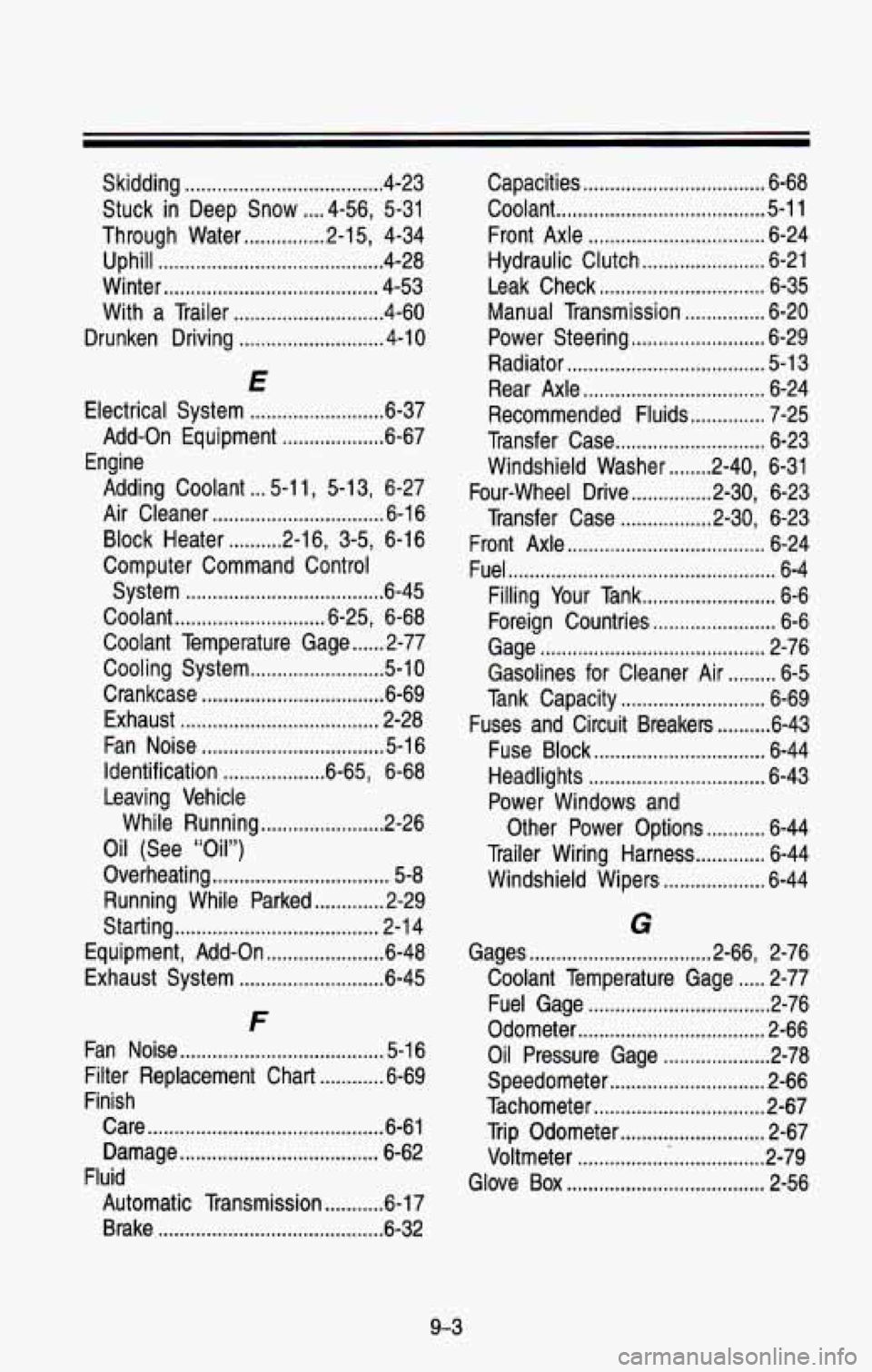
Skidding ..................................... 4-23
Stuck
in Deep Snow .... 4-56, 5-31
Through Water
............... 2-1 5, 4-34
Uphill
.......................................... 4-28
Winter
........................................ 4-53
With a Trailer
............................ 4-60
Drunken Driving
........................... 4-1 0
E
Electrical System ......................... 6-37
Add-on Equipment
................... 6-67
Engine
Adding Coolant
... 5-1 1, 5-13, 6-27
Air Cleaner
................................ 6-1 6
Block Heater
.......... 2-16, 3-5, 6-16
Computer Command Control
System
..................................... 6-45
Coolant
............................ 6-25, 6-68
Coolant Temperature Gage
...... 2-77
Cooling System
......................... 5-10
Crankcase .................................. 6-69
Exhaust
..................................... 2-28
Fan Noise
.................................. 5-1 6
Identification
................... 6-65, 6-68
Leaving Vehicle While Running
....................... 2-26
Oil (See
“Oil”)
Overheating ................................. 5-8
Running While Parked
............. 2-29
Starting
...................................... 2-1 4
Equipment, Add-on
...................... 6-48
Exhaust System
........................... 6-45
F
Fan Noise ...................................... 5-1 6
Filter Replacement Chart
............ 6-69
Finish
Care
............................................ 6-61
Damage
..................................... 6-62
Automatic Transmission
........... 6-17
Brake
.......................................... 6-32
Fluid Capacities
.................................. 6-68
Coolant
....................................... 5-11
Front Axle ................................. 6-24
Hydraulic
Clutch ....................... 6-21
Leak Check
............................... 6-35
Manual Transmission
............... 6-20
Power Steering
......................... 6-29
Radiator
..................................... 5-13
Rear Axle
.................................. 6-24
Recommended Fluids
.............. 7-25
Transfer Case
............................ 6-23
Windshield Washer
........ 2-40, 6-31
Four-wheel Drive
............... 2-30, 6-23
Transfer Case
................. 2-30, 6-23
Front Axle
..................................... 6-24
Fuel
.................................................. 6-4
Filling Your Tank
......................... 6-6
Foreign Countries
....................... 6-6
Gage
.......................................... 2-76
Gasolines
for Cleaner Air ......... 6-5
Tank Capacity
........................... 6-69
Fuses and Circuit Breakers
.......... 6-43
Fuse Block
................................ 6-44
Headlights
................................. 6-43
Power Windows and
Other Power Options
........... 6-44
Trailer Wiring Harness
............. 6-44
Windshield Wipers
................... 6-44
G
Gages .................................. 2-66, 2-76
Coolant Temperature Gage
..... 2-77
Fuel Gage
.................................. 2-76
Odometer
................................... 2-66
Oil Pressure Gage
.................... 2-78
Speedometer
............................. 2-66
Tachometer
................................ 2-67
Trip Odometer
........................... 2-67
Voltmeter
................. ................. 2-79
Glove Box
..................................... 2-56
9-3